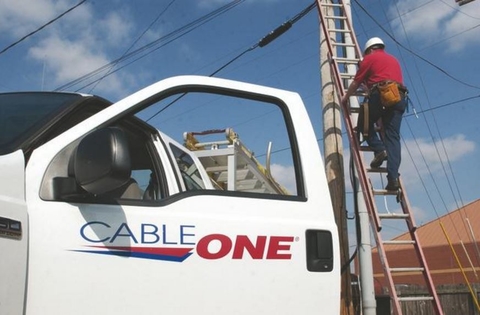Cable One Shares Dip After Releasing Preliminary Q3 Results
Stock falls 5.8% despite strong broadband, financial report; Dow hammered as virus cases rise

Cable One shares were down by nearly 6% ($107.26 each) on Monday after the company released preliminary Q3 results that beat most analysts expectations.
Cable One is scheduled to report Q3 results on Nov. 5. It released preliminary Q3 results on Monday (Oct. 26) mainly because it is readying a $500 million bond offering for general corporate purposes, including mergers and acquisitions.
The results were broadly in line with or above analysts' consensus expectations, but still Cable One shares fell hard on Monday. The stock was down as much as 5.8% ($110.30) each in a rough trading day overall. The Dow Jones Industrial Average fell as much as 750 points during the day amid concerns surrounding increases in COVID-19 cases domestically and in Europe and waning prospects for a stimulus package in the U.S. As of 3 p.m. on Oct. 26, the stock was priced at $1,807.83 each, down $99.42 or 5.2%.
Cable One said it expects Q3 revenue to be between $333 million and $339 million in the quarter, in line with consensus estimates of $336 million. The company also said it should have adjusted EBITDA in the range of $170 million to $174 million, above consensus predictions of $169 million.
Cable One offered no insight as to its video customer metrics for the quarter, but said it expects to add about 26,000 high-speed internet customers, more than four times the 6,400 broadband subscribers it added in the prior year. Not including its most recent acquisition -- ValueNet, purchased in July -- and broadband customer growth was still a healthy 21,000 subscribers.
In a blog post, MoffettNathanson principal and senior analyst Craig Moffett said the broadband increases were impressive and are further evidence that rural and small market consumers are hungry for higher speed internet.
“Rural broadband is all the rage at the moment, with minimal competition and, generally speaking, lower penetration,” Moffett wrote. “While there was no disclosure about broadband ARPU growth (nor about video subscriber metrics), we can guess that they were 1) good, and 2) bad, respectively. That’s not a value judgement; it’s their strategy.”
Multichannel Newsletter
The smarter way to stay on top of the multichannel video marketplace. Sign up below.
Cable One was one of the first cable operators to focus exclusively on broadband service, and has seen its high-speed data ranks rise steadily over the past several years. Moffett added that across the board, cable operators are seeing continued strength in the high-speed data market, with Comcast predicting more than 500,000 broadband additions in Q3 (it reports on Oct. 29), and telcos AT&T and Verizon posting stronger than expected growth.
“...[B]roadband is shooting the lights out. For everyone,” Moffett wrote, adding that strong results at AT&T and Verizon initially were seen as a potential sign that growth could be slowing for cable, but that doesn’t seem to be the case.
While results could be skewed by pandemic-related increases (and pledges not to disconnect consumers for non-payment during the outbreak) and an unlikely rise in household formation, so far it seems any fears of a slowdown are unfounded.
“Assuming a 1% YoY increase in homes passed, Cable One’s residential penetration of passings grew from 32.3 to 33.1% (ex-ValueNet) in a single quarter,” Moffett wrote. “That kind of rapid penetration gain is consistent with a very robust market.”
Mike Farrell is senior content producer, finance for Multichannel News/B+C, covering finance, operations and M&A at cable operators and networks across the industry. He joined Multichannel News in September 1998 and has written about major deals and top players in the business ever since. He also writes the On The Money blog, offering deeper dives into a wide variety of topics including, retransmission consent, regional sports networks,and streaming video. In 2015 he won the Jesse H. Neal Award for Best Profile, an in-depth look at the Syfy Network’s Sharknado franchise and its impact on the industry.

